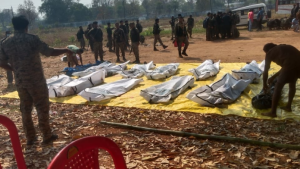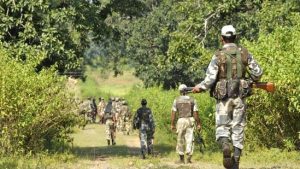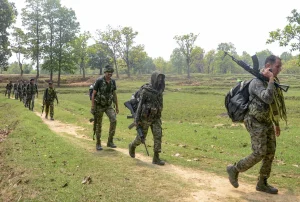Telangana – In a significant breakthrough for India’s counter-insurgency efforts, security forces announced on Wednesday that 31 Naxals killed at Telangana border marked the successful conclusion of a massive three-week operation that captured the strategic Karregutta hills. The operation, codenamed Black Forest, involved an unprecedented 26,000 personnel from central and state forces and concluded on May 11, 2025. The news of 31 Naxals killed at Telangana border represents one of the most significant victories against left-wing extremism in recent years.
Strategic Significance of the Karreguttalu Hills Where 31 Naxals Were Killed

The 31 Naxals killed at Telangana border were operating from a region infamously known as the “black hills,” a 60-kilometer stretch of terrain with elevations ranging from 700 to 900 meters along the Chhattisgarh-Telangana border. This area, characterized by its complete lack of road access, had been an ideal hideout for the banned Naxal groups’ operations. The operation successfully dismantled what authorities described as the unified headquarters of several Naxal formations, including the notorious People’s Liberation Guerrilla Army (PLGA) Battalion 1, the DKSZC, TSC, and the CRC.
Union Home Minister Amit Shah described the operation resulting in 31 Naxals killed at Telangana border as the “biggest operation till date” against Maoist insurgents. He proudly announced, “The hills which were ruled by red terror now proudly hoist the tricolour.” Prime Minister Narendra Modi added that the success demonstrates that the campaign to root out Naxalism is moving in the right direction, emphasizing the government’s commitment to establishing peace in Naxal-affected areas and integrating them into the mainstream of development.
Also Read: Chinese Air Defense Jammed By India: Powerful Strike Reveals Tech Superiority
Unprecedented Scale of Operation Leading to 31 Naxals Killed
The operation was conducted on an unprecedented scale, involving a coordinated effort between central and state security forces. CRPF Director General GP Singh told reporters in Bijapur that the area where 31 Naxals killed at Telangana border were based was “the main den of the Naxals,” where approximately 300-350 insurgents had established their operations. He emphasized that this location had been a “no-go area” for security forces for many years.


“This was the main den of the Naxals. Around 300-350 had settled and were operating from here. It was a no-go area for security forces all these years,” Singh explained, highlighting the significance of the operation that resulted in 31 Naxals killed at Telangana border.
The joint operation received support from the Indian Air Force (IAF), highlighting the multi-dimensional approach of the campaign. The scale of the operation was so extensive that security forces constructed a helipad on top of the hills during their campaign, establishing a permanent presence in what was once exclusively Naxal territory. This strategic advantage helped ensure the success that led to 31 Naxals killed at Telangana border.
Extensive Cave Network Discovered Where 31 Naxals Operated
One of the most significant discoveries during the operation was an extensive network of approximately 250 caves that had been converted into weapons manufacturing facilities. According to personnel involved in the operation, four technical teams from Battalion 1 were manufacturing weapons for the armed insurgency from these cave facilities. The forces uncovered factories producing guns, grenades, and under-barrel grenade launchers, complete with generators powering the production facilities. These discoveries shed light on the sophisticated infrastructure that supported the rebels before 31 Naxals killed at Telangana border disrupted their operations.
CRPF Director General GP Singh highlighted that cave intervention presented a new tactical challenge during the operation. “Generally, our troops are trained for house intervention, vehicle intervention and things like that,” he explained, noting that the troops faced unfamiliar challenges in the cave environment. Despite these obstacles, the operation was successful, with Singh declaring that the 31 Naxals killed at Telangana border marks “the beginning of the end for Naxal groups.”


Extensive IED Network Neutralized During Operation
Security personnel discovered nearly 450 improvised explosive devices (IEDs) planted throughout the hills during the operation that resulted in 31 Naxals killed at Telangana border. Fifteen undetected devices detonated during the operation, injuring 18 personnel. Remarkably, despite these challenges, no security force fatalities were reported throughout the campaign.
Officers noted that the Naxals had established their own markers to identify IED locations, allowing them to navigate safely through the mined area. This sophisticated system of markings demonstrates the level of preparation and entrenchment the insurgents had achieved before the 31 Naxals killed at Telangana border operation disrupted their networks.
Forces continue to sanitize the captured hills for remaining IEDs, which officials believe could number in the hundreds. This painstaking work is crucial to ensuring the long-term security of the area following the operation that led to 31 Naxals killed at Telangana border.
Significant Material Seizures Following 31 Naxals Killed
Among the materials seized after 31 Naxals killed at Telangana border were 12,000 kg of food rations, printers used for producing propaganda, and 818 barrel grenade launcher shells manufactured in the cave factories. These substantial seizures demonstrate the scale and permanence of the Naxal presence that had been established in the Karreguttalu hills.
Across the cave network, forces found four Maoist technical units for arms manufacturing, along with medicine and first aid kits, sewing machines for stitching Naxal uniforms, and 1,100 beer bottles. CRPF DG Singh revealed they had discovered “a new phenomenon of Naxals using beer bottles to pack minimal explosives, which are hard to detect but effective to cause injuries.” This intelligence gained alongside the 31 Naxals killed at Telangana border will be valuable for future counter-insurgency operations.
High-Value Targets Among the 31 Naxals Killed
The 28 Naxals identified thus far among the 31 Naxals killed at Telangana border carried combined rewards of ₹1.72 crore announced by various state police forces. Officials are still verifying reports of senior Maoist members killed or wounded in the operation, highlighting the potential high-value nature of the targets eliminated.
When questioned about top Maoist commander Hidma, who was believed to be hiding in the area, CRPF chief Singh said: “Whatever we had set out to do, we have achieved more than that. It was to dislocate and break the leadership that had congregated at one place.” He acknowledged the difficulties in retrieving bodies in the challenging terrain: “Retrieving bodies is also difficult in that terrain.” This explains why full identification of the 31 Naxals killed at Telangana border remains ongoing.
Strategic Location of the Karregutta Hills


Infamously known as the “black hills,” the 60-km stretch features elevations of 700-900 metres with absolutely no road access, making it an ideal hideout for the banned group’s operations before the 31 Naxals killed at Telangana border operation disrupted their activities.
Much before it became the site of their unified command base, sometime in November or December 2024, the Kerraguttalu hills were used as an escape route by the insurgents to flee into Telangana whenever forces intensified anti-Naxal operations in Chhattisgarh. This escape route has now been cut off by security forces following the operation that resulted in 31 Naxals killed at Telangana border.
Chhattisgarh police chief Arun Dev Gautam said intelligence reports several months ago indicated Naxals from different states were establishing a unified command at the location. “The hills are almost 50 km long and have a width of around 5 to 20 km at different places. In the last year, they had set up a base where 350 armed cadres had taken shelter,” Gautam said. This concentration of forces explains the significance of the 31 Naxals killed at Telangana border in disrupting their organizational structure.
Intense Combat During the Three-Week Operation
During the 21-day operation that resulted in 31 Naxals killed at Telangana border, security forces engaged in 21 separate gunfights with Naxals, highlighting the intensity of the combat operations. Describing the remote and dense nature of the forest, one official added that they even encountered a bear during their mission, underscoring the challenging terrain in which the operation was conducted.
On May 7, while the operation was still underway, Chhattisgarh chief minister Vishnu Deo Sai had posted on social media platform X about 22 Naxals killed in the operation, but later deleted the statement. An officer involved explained: “On May 7, the operation was still on. It was decided not to release any details about the operation until it was complete.” This indicates that the final count of 31 Naxals killed at Telangana border was only confirmed after the operation’s conclusion on May 11.
Part of Broader Counter-Insurgency Campaign

The government has set a deadline of March 31, 2026, to eliminate Naxal violence completely. CRPF DG Singh emphasized the government’s “relentless and ruthless approach to ensure that the country is free of Naxals” by this date. The 31 Naxals killed at Telangana border operation represents a significant step toward this goal.
Security forces have intensified their campaign across multiple states, killing 197 Naxals this year, compared to 280 last year. The 31 Naxals killed at Telangana border operation represents approximately 16% of this year’s total, highlighting its significance in the broader counter-insurgency effort.
The aggressive operations have prompted retaliatory violence, with Naxals killing 16 civilians on suspicion of being police informers. Twenty security personnel have also been killed in the first five months of 2025. These statistics underscore the ongoing nature of the conflict, even as operations like the one resulting in 31 Naxals killed at Telangana border deliver significant blows to the insurgency.
Technology and Tactics Employed in the Operation
The operation that resulted in 31 Naxals killed at Telangana border demonstrated the evolution of India’s counter-insurgency capabilities. The use of air support, specialized cave intervention tactics, and the construction of a helipad in previously inaccessible terrain all highlight the sophisticated approach employed by security forces.
The discovery of the Naxals’ IED marking system and their use of modified beer bottles as explosive devices also provides valuable intelligence about their tactics. This information, gained alongside the 31 Naxals killed at Telangana border operation, will inform future counter-insurgency efforts and potentially save the lives of security personnel.
Final Remarks: A Significant Victory Against Left-Wing Extremism
The successful operation resulting in 31 Naxals killed at Telangana border represents one of the most significant victories against left-wing extremism in recent years. By capturing the strategic Karreguttalu hills, security forces have not only eliminated key insurgents but also dismantled a major hub of Naxal activity that served as both a command center and a weapons manufacturing base.
As security forces continue to sanitize the area and establish a permanent presence in the former Naxal stronghold, the impact of the 31 Naxals killed at Telangana border operation will likely reverberate through the insurgency’s organizational structure. With the government’s 2026 deadline for eliminating Naxal violence approaching, operations of this scale and success will be crucial in achieving that ambitious goal.

